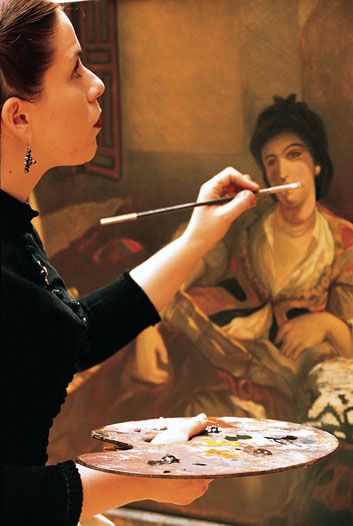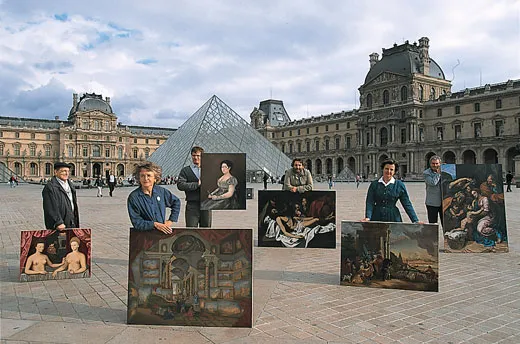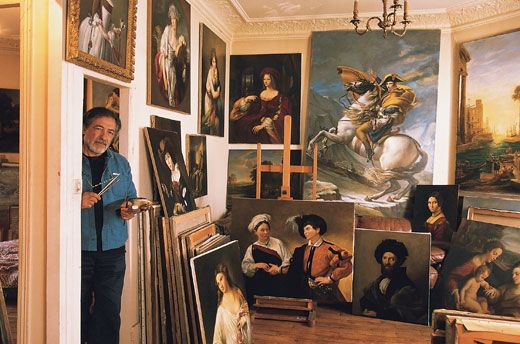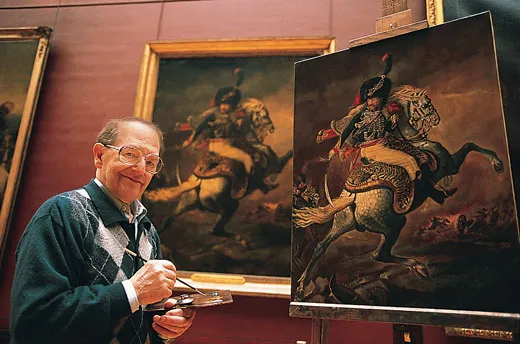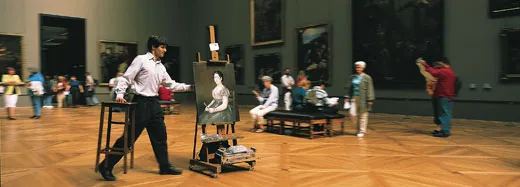Master Class
Like generations of painters before them, artists from around the globe go to Paris to copy the masterpieces at the Louvre
The Louvre has been open only a few minutes, but already crowds are sauntering through its vast galleries. Up on the second floor, in a long, redwalled room devoted to 19th-century French paintings, a group is gathering around a young woman wearing a black velvet tunic and a floor-length silk skirt. Her glossy auburn hair braided and coiled around her head, she sits on a stool before an easel, deftly applying paint to a canvas. Some of the visitors hang back, stare dubiously, then wander off. Others crowd in for a better look, glancing from the famous 19th-century painting on the wall, The Women of Algiers by Eugène Delacroix, to the copy on the easel. “Boy, she’s really good,” someone whispers. “Aw, I bet she’s doing it by the numbers,” comes the response.
Sorrel Smith, a 25-year-old artist from California, is not only producing that curious paradox—an original, fully creative copy—she is also carrying on a venerable tradition. Ever since the museum opened its treasures to public view in November 1793 (one of the indisputable benefits of the French Revolution), it has allowed, even encouraged, artists to hone their skills by copying the masterpieces in its collections. Thousands have done so, including great classical painters from Turner to Ingres, Impressionists from Manet to Degas, and modernists like Chagall and Giacometti. “You have to copy and recopy the masters,” Degas insisted, “and it’s only after having proved oneself as a good copyist that you can reasonably try to do a still life of a radish.”
The Louvre’s attraction is profound. When 23-year-old Marc Chagall arrived in Paris in 1910 from Russia, he went there directly from the train station, suitcase in hand. “Going to the Louvre is like reading the Bible or Shakespeare,” he later said. Paul Cézanne regularly trekked there to copy Michelangelo, Rubens and classical Greek and Roman statues. “The Louvre is the book where we learn to read,” he declared.
Though most of them are women, today’s copyists are an otherwise varied lot. Of the 150 artists who executed 269 copies during the 2000-2001 painting season, nearly three out of four were art students or in artistic professions. But there was also a psychoanalyst, a surgeon, a midwife and 13 retirees. Three out of four, also, were French, but there were 20 Americans, the largest foreign group. Maïten de Ferrier, the enthusiastic head of the office that runs the copyist program, believes a stint at the Louvre is a rite of passage.
“These artists like to follow in the footsteps of all the great painters who have copied here,” she explains. “And, of course, they also come to improve their technique, to find solutions to their artistic problems.” Some, however—like eccentric Surrealist Salvador Dalí, who created a group of provocative renderings of Jean-François Millet’s pious The Angelus—prefer to use masterworks as a point of departure. Picasso, who copied at the Louvre in the 1950s to recharge his creative batteries, produced a series of interpretations of Delacroix’s The Women of Algiers (the same work now being copied by Sorrell Smith) after noticing a marked resemblance between one of the women in the painting and his then companion, Jacqueline Roque.
At the moment, Sorrel Smith’s problem is getting Delacroix’s composition and colors just right. An accomplished technician who likes to do miniature portraits on ivory, Smith came to Paris with the Wells College Program for the Arts (Aurora, New York), where she learned to mix colors and stretch canvases. “Making my own paints with earth pigments means I don’t have to search for the colors the old masters used, because I’m starting from the same point they did,” she explains. “In this painting the colors are very vibrant and at the same time muted, creating a difficult balance. It’s the hardest copy I’ve ever done.”
Difficulty is what most Louvre copyists seek. “It’s a challenge to try to reach the level of the old masters, and to meet it you have to extend yourself,” says Mary Chavance, a French artist who does mainly Impressionist-style landscapes in her Left Bank studio. But here, on the opposite side of the Seine, in the Louvre’s bustling Grande Galerie (devoted to French, Italian and Spanish classical paintings), she is grappling with an aristocrat in gleaming armor by Caravaggio. The work is typical of the Baroque artist’s Tenebrism—the depiction of dramatically illuminated forms emerging from shadow. Her version looks perfect, but she’s not satisfied. “If you don’t copy, you won’t advance,” she says. “But you can’t do it passively. You have to involve yourself deeply in creating something that’s more than just a reproduction of a painting.”
That seems to have been the idea when the museum opened its doors two centuries ago. “Each visitor should be able to put his easel in front of any painting or statue to draw, paint or model as he likes,” proclaimed an early official. But the Louvre was soon so flooded with artists that the museum had to start issuing authorizations and limiting hours for copyists. (Today, copying is permitted from 9 a.m. to 1:30 p.m., September through June, except Tuesdays, Sundays and holidays.) In the early days, art students, never known for their decorum, often had to be reminded to refrain from games, singing and horsing around in what was supposed to be, according to Louvre authorities, a “sanctuary of silence and meditation.”
Not everyone came to the Louvre for purely aesthetic reasons. In the mid-19th century, mothers often chaperoned their copyist daughters, concerned that representations of scantily clad bodies might be corrupting or that male copyists had more on their minds than offers of artistic instruction. To such prospective swains, the 19th-century novelist Champfleury offered an effective approach: “Copy a painting next to hers, then ask to borrow some cadmium or cobalt. Then correct the odious mess of colors she calls a painting (they’re always glad to get advice) and talk about the Old Masters until the Louvre closes and you have to continue the conversation in the street. Improvise the rest.”
By the middle of the 19th century, hundreds of artists were busily copying masterpieces, mainly to satisfy orders from clients. Many visitors, wending through a veritable forest of easels, ordered copies on the spot. Thus the Louvre offered artists the possibility of income (though by the 1890s, photography had reduced demand), as well as a dry and heated place to work.
Still, many of today’s Louvre copyists sell their works. A few art galleries near the museum market them, and some artists, such as Amal Dagher, who has been copying for 30 years and is considered the unofficial dean of Louvre copyists, sell directly to visitors. Born in Lebanon, the affable 63-year-old Dagher studied for four years at Beirut’s Academy of Fine Arts, and later in India, Thailand and Japan, before settling in Paris. He is working on a copy of a portrait of Mademoiselle Caroline Rivière by French neoclassicist Jean-Auguste-Dominique Ingres, who, along with Delacroix, is among the most copied of the Louvre’s masters because of his rigorous composition and subtle coloring. (One of the world’s most famous paintings, Leonardo’s Mona Lisa, is one of the least copied—partly because the crowds that flock to the painting make it hard for an artist to set up an easel and partly because, according to Ferrier, its fame intimidates.)
“Caroline Rivière died at 14, about a year after she posed for Ingres,” says Dagher. “I believe he was trying to present an idealized vision of her. She is almost an Italian Madonna, and the challenge here is to achieve the form that he gave her, making her seem to float above the background.” Despite his many years of copying, Dagher admits to feeling a sort of stage fright every time he faces a blank canvas. “That’s a good sign,” he says. “If you’re too satisfied with yourself, you can’t improve.”
Dagher also values the Louvre for the access it gives him to the public. “Not many people passing through actually buy my copies,” he says, “but often they will ask me to do something else for them.” Some want him to make copies of portraits of their ancestors so they can give them to other family members. One American visitor asked him to paint a reproduction of a Versailles ceiling fresco at the visitor’s home in Connecticut. “The gold-leaf molding alone cost nearly $60,000,” Dagher recalls. “That was a lot more than I asked for doing the painting.”
But not everyone wants to sell their copies. Gilles Malézieux is interested only in creating his own collection. Malézieux, 45, knows the Louvre better than most. He works there as a security officer. When not keeping an eye out for pickpockets, he returns to the museum with brushes and paint. “I take days off from my vacation time to do this,” he says. “I’d rather copy than go to the beach.” Malézieux began copying six years ago because he loved paintings but couldn’t afford to buy them. Self-taught, he does four or five copies a year. He’s currently working on a rendering of The Ferry by 17th-century Dutch landscape painter Salomon van Ruysdael. “I chose this one because it’s a seascape—a glaze without much detail,” he says. “That lets me dream a little, and that’s enough vacation for me.”
Not far away in a room given over to 17th-century Dutch painters, Tsutomu Daitoku is hard at work on a copy of Jan Vermeer’s The Lacemaker, with its assiduous young lady bending to her delicate handiwork. Tall, thin and earnestlooking, the 25-year-old Japanese amateur taught himself to paint by reading books and studying works in museums. “I came to Paris just so I could copy here at the Louvre,” he says. “I plan to become a professional artist when I return to Japan, moving around the country and doing all kinds of paintings. This one by Vermeer is very difficult, especially the”—he consults a Japanese-English pocket dictionary—“‘coloring.’”
In order to copy at the Louvre, non-French artists like Daitoku must attach a photocopy of their passport and a recommendation from their embassy or consulate to their application, but otherwise the procedure is the same as for French citizens—a simple form specifying the desired starting date and the painting to be copied. No samples of work are requested. Permits are good for three months, and the museum provides each artist with an easel and stool. Except for the requirement that copies be one-fifth smaller or larger than originals and that the artist’s signature cannot be reproduced, the Louvre imposes very few rules on copyists, though it further protects against any temptation to produce a forgery by affixing an official stamp to both sides of each copy and carefully inspecting the works before they leave the museum. “But this is not a problem we have here,” says Ferrier. “If someone really wants to make a forgery, it’s much simpler to work from a good color photograph in the secrecy of their own studio.”
The Louvre is more liberal than, say, Washington’s National Gallery of Art, which has a long list of rules and requires reference letters, original samples of paintings and an interview from applicants. But the Louvre’s Ferrier thinks that “we should leave the artists as free as possible.” One painter who has benefited from this attitude is American Will H.G. Thompson, a slender man of 30 with thick dark hair. A professional artist who won an award for a painting at Paris’s Salon des Beaux-Arts, Thompson was born in Switzerland and grew up in Europe. He studied art at the Pennsylvania Academy of Fine Arts in Philadelphia and now makes his home in Paris. In a dimly lit room devoted to Spanish classical paintings, he is copying Francisco de Goya’s Young Woman with a Fan, a portrait of a poised young lady with a distant, dreamy gaze.
“I got a good foundation at the PennsylvaniaAcademy, but you never stop learning,” Thompson says. “When I copy a masterpiece, I get a sort of mental trip out of it, applying the paint differently, using light and dark the way the artist did. It’s like taking a lesson from an old master.”
Like most Louvre copyists, Thompson often chats with some of the thousands of visitors who enter the museum each day. “There’s a real exchange between the copyists and the public that we consider very positive,” says Ferrier. “Copyists working amid the visitors enhance the way the public sees paintings and incites them to look more closely with a more analytical approach. They start noticing how the artist actually did the work.”
Those who frequent the museum have come to know a small man of 77 with pale blue eyes and a gentle manner. Bruno Nini has been copying nearly every day since 1990, when he retired as maître d’ at a restaurant in Paris’s Austerlitz train station, where he began his days by taking delivery of 5,000 croissants at 5 a.m. Now he is working on a copy of Gabrielle d’Estrées and One of Her Sisters, a tantalizing portrait of the mistress of Henri IV by an anonymous 16th-century painter of the school of Fontainebleau.
“I learned most of my technique from books,” Nini says with obvious pride. “After realizing I wanted to paint, I sought out street artists and tried to get tips from them. Then one day I came here and saw copyists at work. I knew that was what I wanted to do.” Nini estimates he’s done more than 100 copies, some of which he’s sold; the others hang on the crowded walls of his Paris apartment. He’s an amateur in the truest sense of the term—someone who passionately loves what he’s doing. “Sometimes, when I see the figures in a painting coming to life under my brush strokes,” he says, “tears come to my eyes.”
